Accident Reporting 2015
Reporting accidents with ammunition and explosives is very important to generate lessons learned. Sharing the information with other nations and organizations helps to prevent similar events in the future. MSIAC has a number of ongoing activities to contribute to these goals.
1. Accident reports on the public MSIAC website
An overview of recent accidents is given on this website in the Accident Reporting section. Over the last year no updates were made, but a new report for the year 2015 is now available. The future intent is to provide updates each quarter in conjunction with the newsletter. The main focus is on accidents with ammunition, but accidents in industry (e.g. with fertilizer) and explosive attacks (e.g. IED) may also provide relevant information in terms of the damage effects.
Another great source of information is the Small Arms Survey based in Geneva, Switzerland. They collect statistics about Unplanned Explosions at Munitions Sites (UEMS) that take place around the world. The information can be browsed by country or by year. The number of fatalities and injuries are given, as well as the cause if available. The 2014 UEMS Handbook gives a 35-year global review of UEMS incidents.
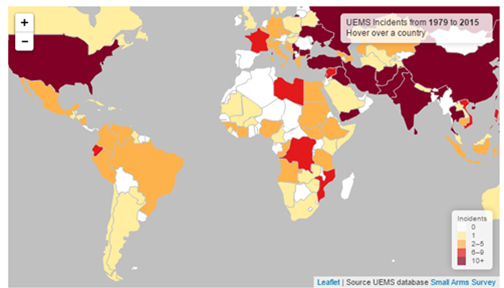
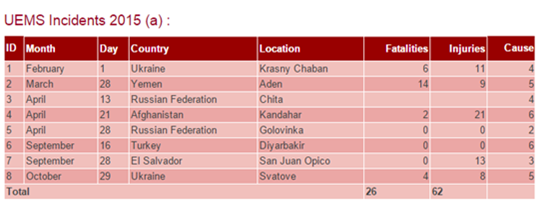
Meaning of cause codes: 1. lack of surveillance leading to ammunition deterioration, 2. inappropriate storage infrastructure and systems, 3. handling errors and inappropriate working practices, 4. Failure to take into account external, environmental influences and events, 5. Poor security, 6. Cause currently undetermined or unrecorded.
2. National accidents database exchange and MADX
More detailed accidents information can be found in the “MSIAC Accident Database Exchange (MADX)’’ on the MSIAC portal. This database is accessible to contributing nations only; currently Australia, Canada, France, UK, and US. MSIAC and AC/326 SG-C encourage other nations to join.
Tom Taylor, the former TSO Ammunition Safety, Storage and Transport, was responsible for the development of the MSIAC Accident Database Exchange (MADX). This tool allows easy searching and analysis of the accident reports. Searching for weapon type, explosive substance, location, time frame, or part of the life cycle phase in which the accident took place, yields a list with relevant results. Tom’s successor, Martijn van der Voort, continues the development of MADX. After a testing period, the aim is to add MADX to the MSIAC suite of tools towards the end of 2016.
MSIAC is looking for beta testers to provide feedback on MADX. Should you like to test the application, please contact Martijn van der Voort via his email (m.vandervoort@msiac.nato.int). Note you must be an individual from one of the five contributing nations listed above.
3. Forensic analysis of ammunition accidents
An important part of the accident investigation is to obtain information on the amount and type of ammunition or explosives involved in the event. This can be done based on damage observed to the surroundings such as crater size, structural damage, window breakage, and debris and fragment throw. In 2012 MSIAC analysed the Cyprus accident based on available information.
MSIAC encourages the use of quantitative methods for forensic analysis of explosions. Martijn van der Voort, in his previous job at TNO (Rijswijk, the Netherlands), was responsible for the development of the Inverse Explosion Analysis (IEA) tool. This tool enables inverse calculation of the explosive charge mass based on various types of damage at and around the accident location. The tool was applied in a number of case studies; the Khobar tower attack (1996), the Enschede firework disaster (2000), and the Oslo bombing (2011).
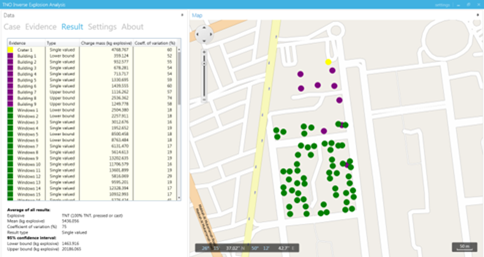

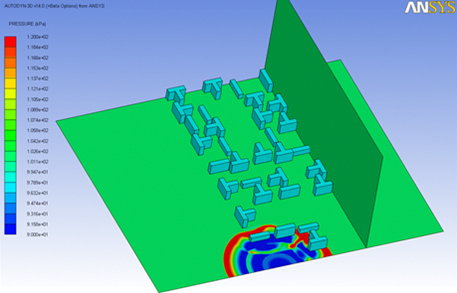
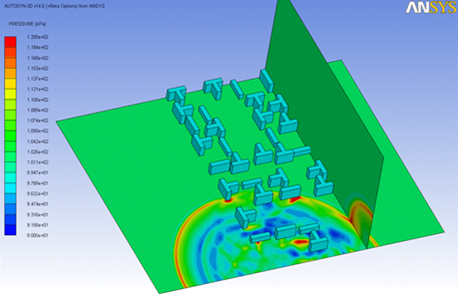
Fig 1: Screenshot of the Inverse Explosion Analysis tool and its application to the Khobar tower attack (1996). Foto 2: crater and heavily damaged buildings. Bottom 3-4: Detailed analysis (CFD) of the blast propagation with Ansys AutoDyn.
The scientific background of the various models and the first two case studies are described in a recent publication in Forensic Science International.
Results have also been presented at various symposia and conferences; the most recent one was the ISIEMS conference in Florida, 9-13 November 2015.
The work was conducted under the EU FP7 project HYPERION. Consortium leader FOI of Sweden organized a demonstration on 23 and 24 September at the Grindsjon test site near Stockholm. Three trials were performed involving an outside detonation near facades with glazing, a buried explosive and an explosion inside a building. The IEA tool gave predictions that are in close agreement with the actual amount of explosives used, which was also confirmed with overpressure measurements. A movie summarizing the results is available here.
The current Point of Contact at TNO for (forensic) analysis of explosions is: Ms. Ans van Doormaal (ans.vandoormaal@tno.nl).
Martijn van der Voort, MSIAC Munitions Safety, Transport and Storage.


